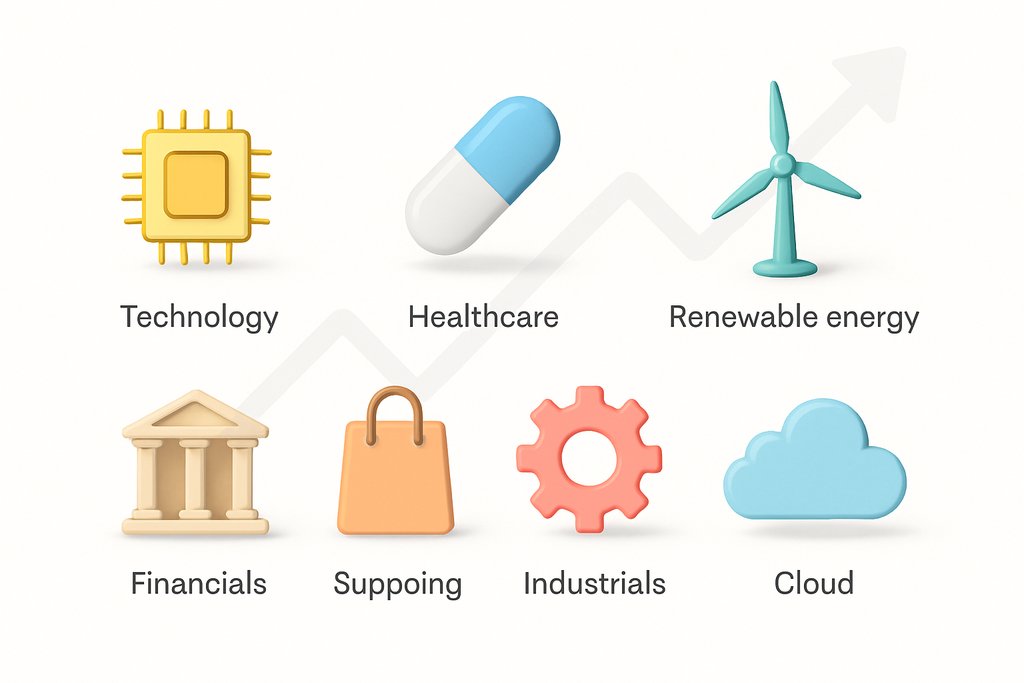Best Stocks to Buy Now: A Practical Investor Guide
A clear, repeatable framework to find the best stocks to buy now, explore timely themes, and automate alerts and execution with Obside so you can act with confidence.

Finding the best stocks to buy now is a common question with a surprisingly complex answer. Markets move fast, narratives change, and what led last month may lag today. What most investors need is a short list of high conviction ideas, a way to validate them quickly, and a plan to act at the right time without second guessing.
This guide gives you exactly that. You will learn what makes a stock one of the best to buy now, a repeatable process to surface candidates, timely themes to explore, and a practical way to automate monitoring and execution so you never miss a move.
What you’ll learn
- A simple definition of “best stocks to buy now”
- A 3 pillar framework to find and time entries
- How to automate alerts and orders with Obside
Table of contents
- What “best stocks to buy now” really means
- The core framework to find the best stocks
- Market context to narrow your hunt
- Examples by theme to research now
- A step by step playbook for this week
- Benefits and key considerations
- Turn ideas into actions today
- Conclusion
- FAQs
What “best stocks to buy now” really means
The best stocks to buy now are not simply the most popular tickers or the top gainers of the week. They are companies where three things line up at the same time.
- The underlying business is strong enough to endure and compound.
- There is a visible catalyst that can unlock value or accelerate growth soon.
- The current price is attractive relative to future cash flows, with a supportive technical setup.
That is a high bar, and it shifts with your time horizon, risk tolerance, and diversification. A long term investor may favor durable compounders at reasonable prices. A swing trader may prioritize earnings revisions, momentum, and tight risk controls. Define your rules, then apply them consistently.
If you want a fast way to go from idea to action, Obside was built for this. Chat in plain language, create high quality alerts in seconds, and trigger automated orders with your connected brokers once conditions are met. With ultra fast backtesting and live execution, you move from research to results without switching tools.
The core framework to find the best stocks to buy now
When researching candidates, filter everything through three pillars: quality, growth with catalysts, and valuation with timing.
1. Quality you can hold through storms
Start with the engine of the business. Favor high and stable gross margins, expanding operating margins, strong returns on invested capital, predictable free cash flow, and conservative balance sheets. These markers signal durable moats and management discipline.
Learn core metrics on Investopedia: ROIC, price to earnings, and free cash flow.
Management quality matters. Track capital allocation, buyback discipline, and whether acquisitions created value. Read shareholder letters and listen to earnings calls to gauge clarity and consistency.

2. Growth with visible catalysts
Great businesses that are not growing rarely lead the market. Today, credible growth often clusters around a few secular themes: AI infrastructure and automation, cloud and cybersecurity consolidation, energy and resource security, obesity and metabolic therapies, and onshoring with advanced manufacturing. Inside each theme, look for rising order backlogs, new product cycles, or evidence of pricing power.
Analysts are not always right, but a drumbeat of positive EPS revisions is a useful tell. Learn how revisions and surprises move prices with earnings surprises.
3. Valuation and timing that stack the odds
Price still matters. Compare growth to valuation rather than focusing on multiples in isolation. Use free cash flow yield versus growth rate, the rule of 40 for software, PEG ratios for growth compounders, and asset based measures for energy or financials where appropriate.
Respect timing. You do not need to be a chartist to benefit from basic confirmation. Higher highs and higher lows, breakouts from long consolidations on strong volume, bullish moving average crossovers, and overbought or oversold signals near key levels can refine entries.
If you want to codify these rules and remove emotions from entries and exits, Obside lets you do it in plain language. Ask Obside Copilot to alert you when a stock breaks its 200 day moving average on above average volume, or to buy a starter position only after an earnings beat above 5 percent with raised guidance.
Market context to narrow your hunt
The right list of best stocks to buy now depends on the macro backdrop. You do not need to forecast perfectly, but you should align your shortlist with what markets are pricing.
If growth is steady and inflation trends lower, quality growth, AI infrastructure, and top consumer names often lead. If inflation is sticky and rates stay higher for longer, energy, cash generative value, and companies with pricing power can outperform. In a slowdown, defensives like healthcare and staples with resilient cash flows tend to shine.
Watch leadership rotation across benchmarks. The S&P 500 composition shows sector concentration. Monitor breadth, sector ETFs, and credit spreads to decide whether to lean into momentum or seek mean reversion.

Examples of the best stocks to research now by theme
This is not a shopping list. Treat these as timely themes with representative leaders to study. Your picks will depend on your goals and valuation discipline.
AI infrastructure and automation compounders
The AI buildout is a multi year capital cycle. Picks and shovels often show the best mix of quality, growth, and pricing power. Graphics and accelerated computing suppliers to data centers, high margin chip designers in networking and custom silicon, and equipment makers enabling advanced lithography deserve a close look. Risks include cyclicality and high expectations, so insist on disciplined entries and watch for order normalization.
Financials with scale and cost of capital advantages
In banking, size and cheap funding are real moats. Well capitalized global banks with diversified fee streams, strong risk controls, and leading digital platforms can compound book value through cycles. In asset management, favor dominant franchises with sticky assets and operating leverage that expands margins in up markets.
Defensible consumer and membership models
Membership retailers and brands with high renewal rates, private label strength, and efficient operations can deliver steady growth through varied macro scenarios. The best reinvest savings into price leadership, which deepens loyalty and widens moats. Watch sustained traffic growth, category expansion, and disciplined unit economics.
Healthcare innovators
Metabolic health and obesity treatments, oncology platforms, and precision medicine remain powerful drivers. Leaders combine clinical data advantages, manufacturing scale, and robust pipelines. Valuations can embed optimism, so triangulate market size, production capacity, and competitor responses. Diversified healthcare with durable franchises and consistent cash generation adds resilience.
Energy and resources with capital discipline
Producers that cut leverage, return cash, and invest only at high hurdle rates stand out when inflation is sticky or geopolitics tighten supply. Integrated majors and low cost producers benefit from scale and diversified cash flows. Midstream infrastructure with long term contracts can add stability. Given commodity volatility, position sizing and risk controls are essential.
A step by step playbook to build your shortlist this week
Step 1: Define your mission
Decide your time horizon, risk tolerance, and position sizing rules before you look at tickers. For instance, target 8 to 12 positions, cap any single name at 10 percent, and plan to trim into strength.
Step 2: Screen for quality and growth
Use a screener to filter for revenue growth above your threshold, operating margins trending up, and returns on invested capital above the sector median. Overlay positive earnings revisions and manageable valuation ranges.
Step 3: Read two primary sources per candidate
Read the latest shareholder letter or investor day deck and the most recent earnings call transcript. You will quickly see if the story aligns with your thesis.
Step 4: Check the chart for timing
Look for consolidation breakouts on strong volume, pullbacks to rising moving averages that hold, or bases forming after large runs. You are not predicting every wiggle. You want a rational entry with a clear invalidation level.
Step 5: Automate your monitoring with Obside
This is where you move from theory to execution. With Obside Copilot, describe what you want in plain language, then let the platform watch the market and execute when your rules are met.
- Notify me if RSI crosses 70 on a stock I name and MACD turns bearish.
- Alert me if Company X beats earnings by more than 5 percent and raises guidance.
- Sell my cyclical basket if the S&P 500 drops by 10 percent on a closing basis.
- Buy 500 dollars of a stock if it breaks its 52 week high on double average volume.
- Alert me if Apple announces a new product, or tell me when OpenAI announces a new AI model.
You can also codify full strategies. For example, buy on a bullish RSI divergence on a 15 minute chart, set a stop at the low of the day, and take profit at 10 percent. Or maintain a model allocation with automatic rebalancing if volatility spikes.
Obside’s backtesting engine validates strategies in seconds and then runs them automatically with your connected brokers and exchanges. It won the Innovation Prize 2024 at the Paris Trading Expo and is supported by Microsoft for Startups.

Benefits of a disciplined approach, and key considerations
A clear framework reduces noise. You spend less time chasing headlines and more time compounding in high quality businesses. Catalysts keep you honest about near term drivers, which helps with timing and position sizing. Valuation discipline protects you from paying any price for growth. Using automation through Obside helps you react in real time and avoid hesitation.
Important considerations remain. Great stories can be fully priced. Growth can slow after a big product cycle. Macro shocks can hit several sectors at once. Liquidity can vanish during stress, and even strong companies can experience large drawdowns. Diversification, humility about forecasts, and consistent risk controls are essential.
Turning the best stocks to buy now into actions today
Here is how to put this into practice over the next 24 hours.
- Build a watchlist of 10 to 20 candidates across the themes above. Write a two sentence thesis and the price or condition that would trigger a buy.
- In Obside, create targeted alerts in plain language. For example: alert me if this stock closes above its 50 day moving average on 1.5 times volume, or notify me if consensus EPS for next quarter is revised up by more than 3 percent in the last 30 days. Buy 300 dollars automatically if price pulls back 5 percent to the 200 day moving average and RSI holds above 45.
- Backtest a simple entry and exit rule on your favorite names. If results are acceptable, connect your broker and let Obside manage entries and rebalancing based on your rules.
Conclusion: your edge is process plus speed
The best stocks to buy now are a moving target. With a clear process and the right tools, you do not need to guess. Focus on quality businesses with catalysts, buy them at reasonable prices with supportive technicals, and use automation to act without hesitation. Start with a shortlist that fits your goals, set precise alerts and rules in Obside, validate with quick backtests, and scale what you trust.
This is an educational resource, not financial advice. Markets carry risk. Test before you commit, start small, and always invest according to your risk tolerance.
Create your first automated alert
FAQs about the best stocks to buy now
What are the best stocks to buy right now for beginners?
Beginners often do well starting with high quality, large cap companies that generate consistent free cash flow and have clear competitive advantages. Focus on a handful of names you understand well, then layer in automation with Obside to help with entries, alerts, and simple risk controls.
How many stocks should I hold in a portfolio?
Many individual investors find that 8 to 20 positions balance diversification and focus. The right number depends on your time and research bandwidth. If you hold more names than you can monitor, use Obside to centralize alerts on earnings, price levels, and technical conditions.
Is it better to buy growth or dividend stocks now?
Both can work. Growth stocks can compound faster when catalysts and execution align. Dividend stocks can provide income and often show resilience in choppy markets. Match your choice to your goals and risk tolerance, anchored in quality and valuation discipline.
Should I wait for a dip or buy now?
Time in the market usually beats timing the market, but entries still matter. If a stock fits your thesis and trades near support with clear risk levels, scaling in with partial buys can reduce regret. Use Obside to automate staged entries at predefined prices or technical signals.
How can I avoid buying into hype?
Require evidence. Look for accelerating revenue, margin expansion, rising free cash flow, and positive earnings revisions. Cross check narratives with data, and insist on reasonable valuations. Set alerts in Obside to act only when your specific conditions trigger.
